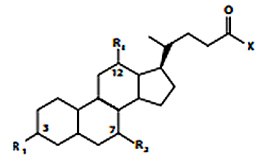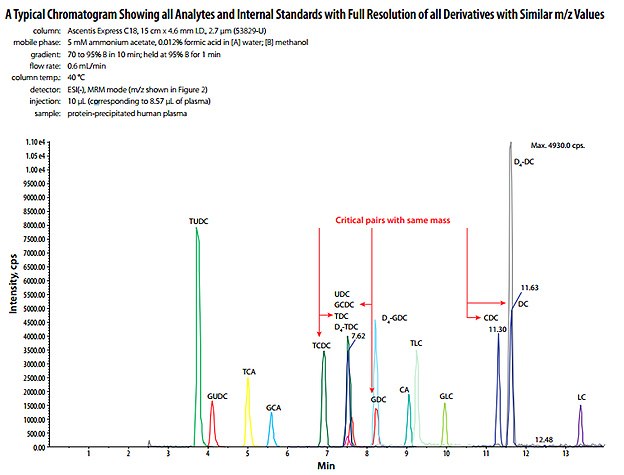Bile Acids Kit for LC-MS
Bile Acids Research Significance
Bile Acids (BA) are synthesized in the liver and play important roles in cholesterol homeostasis, absorption of vitamins and lipids, and various key metabolic processes. BA analysis is an important area of study in various settings including clinical laboratories and ADME and Toxicology studies. Abnormalities in BA biosynthesis and accumulation are linked to multiple human diseases and mechanisms causing hepatotoxicity including drug-induced cholestasis.
ADME/Tox Liver Model for Bile Acids Research
HepaRG (5F Clone) control cells (Cat. No. MTOX1010-1VL) is a highly active human liver cell line for bile acid research.
Methodology
The quantitation of bile acids from plasma, cells or media by tandem mass spectrometry (MS/MS) presents an analytical challenge. When employing collision-induced dissociation, bile acids will either form no useful fragments for quantitation (unconjugated), or produce a charged fragment originating from a conjugation group (conjugated taurine and glycine salts).
As three of the bile acids have the same molecular weight and elemental composition, they cannot be differentiated by MS/MS alone and require chromatographic separation of the group in both their unconjugated and conjugated forms. To enable separation, an Ascentis® Express C18 analytical column based on Fused-Core® technology is used.
Structural Overview of Bile Acids and Conjugated Salts with Corresponding m/z Values

Figure 1.
Sample Preparation
Plasma proteins are removed with addition of 900 µL of acetonitrile containing deuterated internal standards, to 250 µL of human EDTA plasma. The mixture was vortexed, centrifuged, and the supernatant evaporated before being reconstituted in a 50:50 solution of methanol and water. A 10 µL aliquot (corresponding to 8.57 µL of plasma) is injected into the HPLC.
Results
A chromatogram showing the fifteen bile acid species separated on an Ascentis® Express C18 Fused-Core® column is shown below. The method is fast and robust and allowed the compounds to be measured individually rather than the alternative measurement of a total concentration by colorimetric kinetic enzyme assays. This is particularly useful in research into the role of individual bile acids as signaling molecules. The kit is suitable for ADME/Tox and clinical laboratories.

Figure 2.
To continue reading please sign in or create an account.
Don't Have An Account?